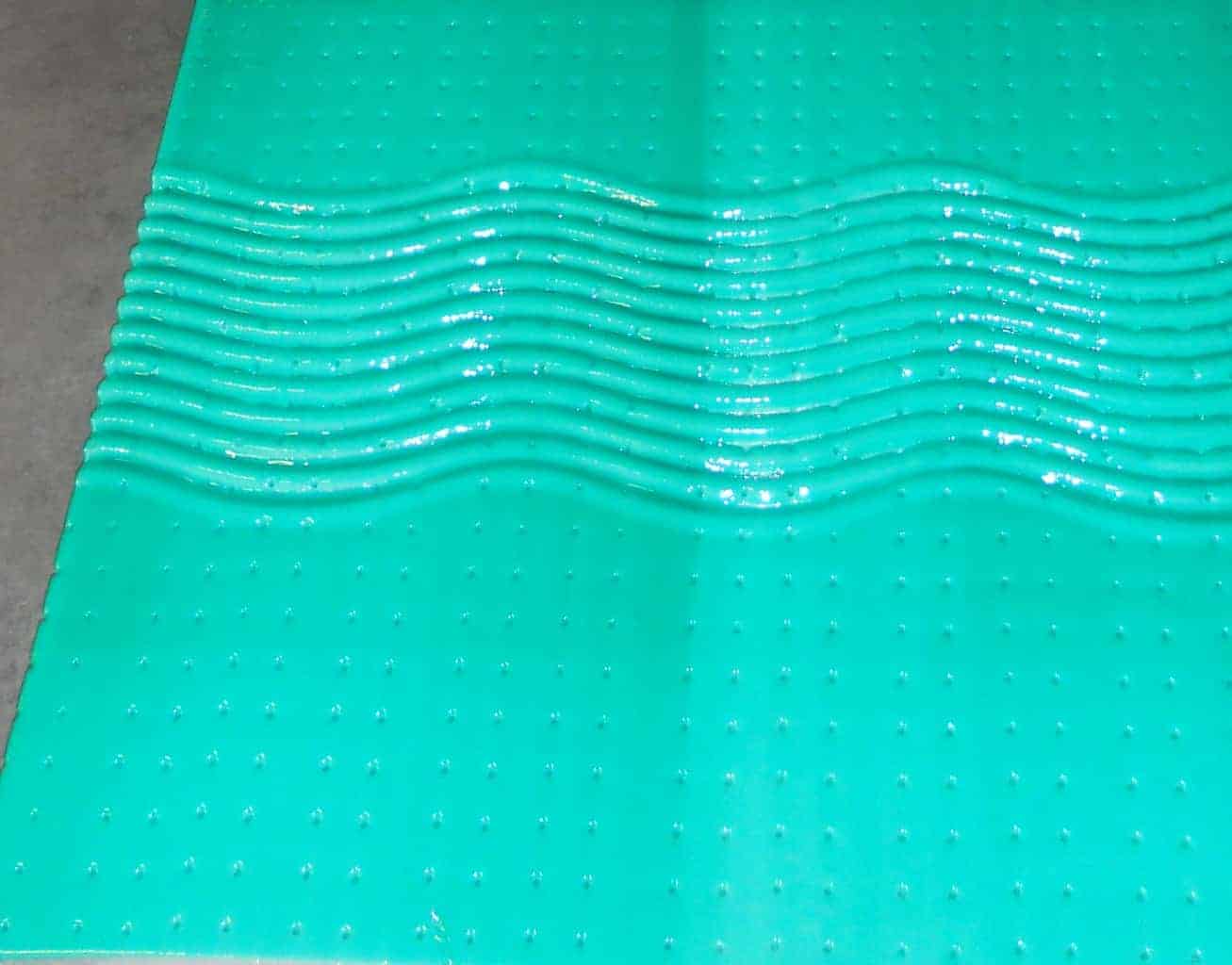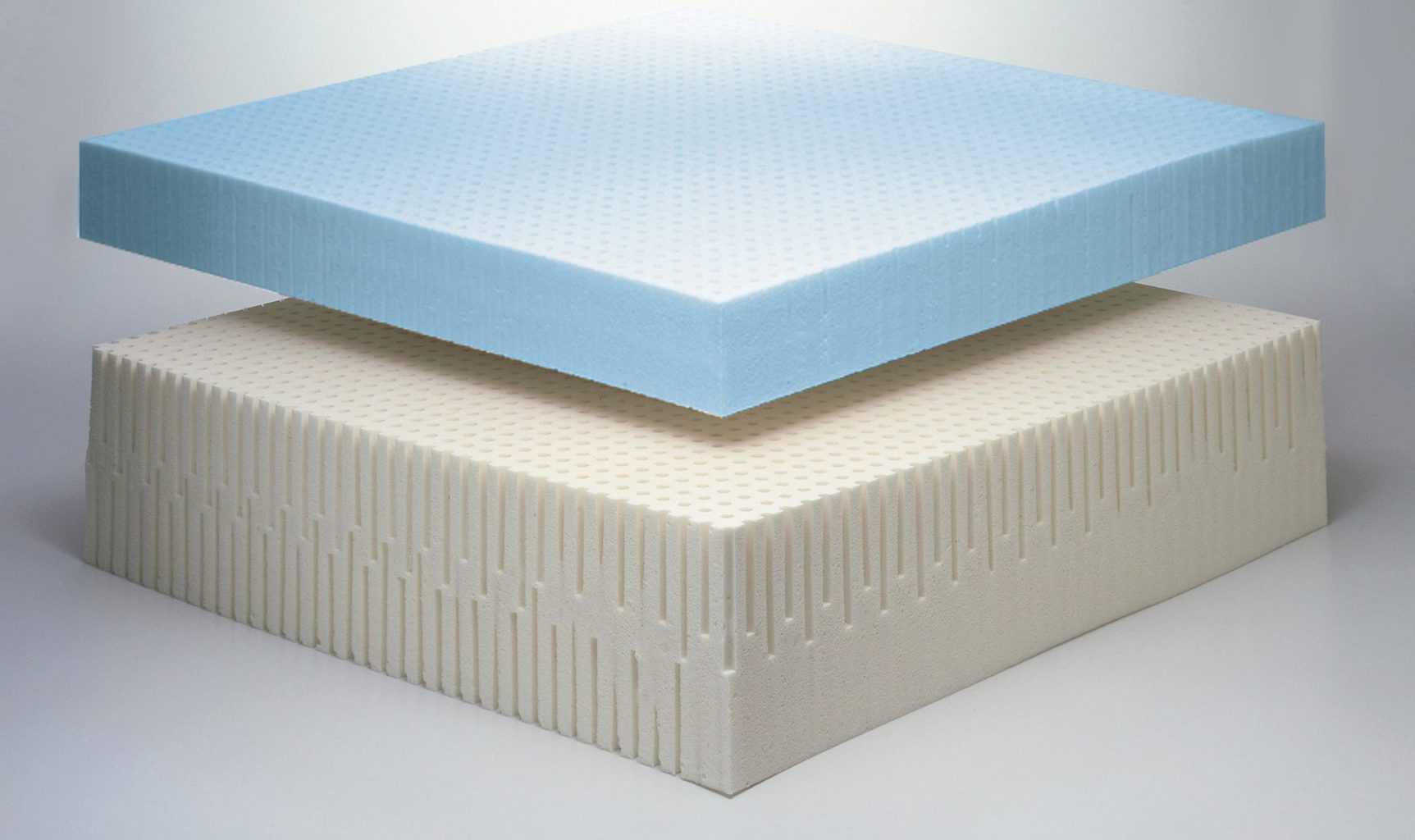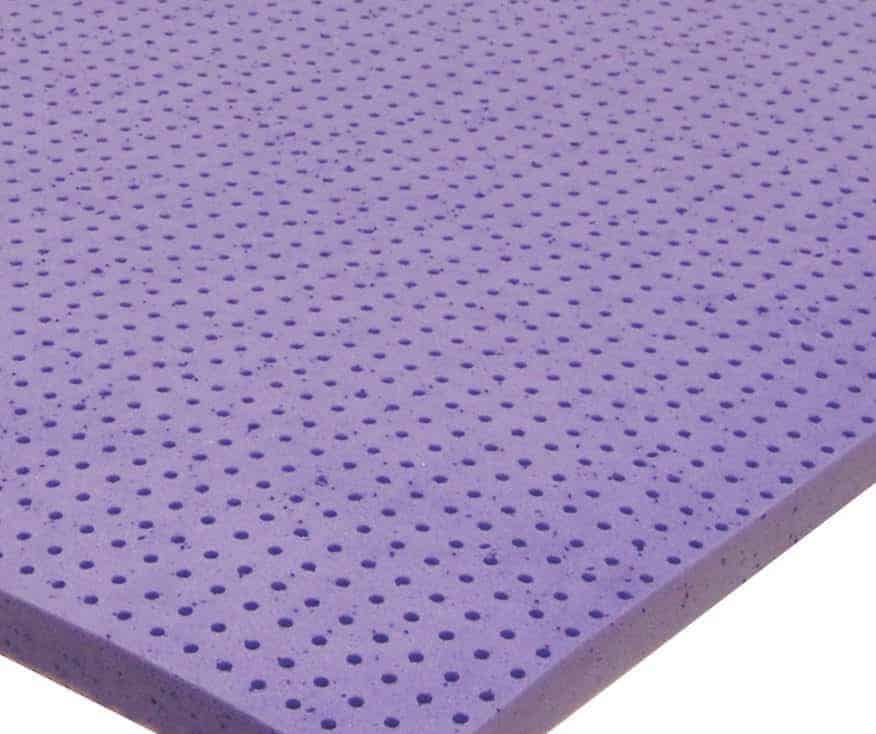Mattress manufacturers pile on the gel components
BY GARY JAMES

Flexible Foam Products, based in Spencerville, Ohio, entered the gel category in late 2011 with G Flex, a 100% urethane gel-infused version of its AdaptaFlex memory foam.
Long used by the European mattress industry, gel foam was a quiet components segment in the United States until mattress major Serta hit a home run with its iComfort introduction in 2011. Since then, top foam suppliers across the globe have accelerated product development efforts, launching new latex and visco-elastic applications that incorporate gel to tap emerging market opportunities.
The flurry of activity was evident at this summer’s Las Vegas Market, where mattress makers introduced a wave of gel foam bedding to retailers. Among the companies featuring gel lines were Carolina Mattress Guild, Comfort Solutions, Englander, E.S. Kluft & Co., Five Star Mattress, Kingsdown, Spring Air International, Pure LatexBLISS, Restonic and Therapedic International. Serta continues to build on the success of iComfort with new models, too.
In some cases, models feature a polyol gel that is “infused” directly into the foam before it’s poured to create a milkshake-like blend. In other applications, gel is embedded or flecked into the foam, injected into foam pinholes or spread like jelly into foam contours.
The iComfort line features a top comfort layer of Cool Action memory foam containing infused beads of Serta’s exclusive MicroSupport gel. Serta says the system provides seven times more cooling comfort and two times more support than ordinary memory foam, resulting in a sleep experience that is “Smarter. Cooler. Better.”
Most of the gels available for use by the bedding industry today were developed for medical settings to prevent or alleviate pressure sores among bedridden patients. The same comfort and pressure-relieving properties hold strong appeal for consumers and have become part of the marketing pitch for gel foam mattresses.
Here BedTimes looks at some of the new gel foam offerings available to mattress producers from foamers. For more suppliers of gel foams and other gel components, check the BedTimes Supplies Guide.
Thinking ‘green’

In March, Tielt, Belgium-based Latexco introduced BiOH Gel Latex, a latex foam with a new corn-based BiOH polyol from Cargill. The version shown here features a wave
pattern that provides back support and pressure-point relief.
Introduced at ISPA EXPO 2012 in March, Latexco’s newest gel product is BiOH Gel Latex, a latex foam incorporating a new corn-based BiOH polyol from Cargill. According to Latexco, this polyol replaces 100% of the petroleum polyols in a typical urethane gel foam, reducing oil dependency and increasing the renewable content in finished foam products.
“BiOH Gel Latex has clear benefits for the environment, but it also has other features, such zoning and load-spreading flexibilities,” says Kevin Callinan, vice president of sales for the company, which has worldwide headquarters in Tielt, Belgium. “Since all of our bio gel toppers are open-cell products, we can adjust the zoning to maximize air flow and enhance thermal-regulation properties.”
This gel-foam combination also enables Latexco to create ridge or wave patterns that provide load-spreading back support and pressure-point relief. The high density of the gel evenly distributes pressure, while pinholes in the surface allow balanced ventilation.
Along with BiOH Gel Latex, Latexco offers Puralux Gel, a solid thermoplastic polymeric gel application that is part of the Puralux Memory line, which includes standard latex and a hybrid visco-elastic latex. This gel product’s coverage can be adjusted by Latexco to levels ranging from 25% to 100%, offering bedding producers the ability to hit a range of price points and create exclusive applications.
“At 100% coverage, a producer may be spending more than they need to, depending on the nature of the mattress and market niche,” Callinan says. “With Puralux Gel, they can adjust the coverage to whatever percentage makes the most sense for their line’s requirements. If they want 50% coverage, with a greater density in the lumbar region, we can do that.”
Like BiOH Gel, Puralux Gel is a nontoxic, shock-absorbing product with load-spreading back support and pressure-point relief properties.
This fall, Latexco plans to expand its gel foam line with Theta Comfort, a patented latex production technology for toppers and pillows that incorporates phase-change materials. Phase-change materials—materials that morph from solid to liquid as heat increases—absorb energy when the environment or body temperature goes up, storing this energy temporarily for a cooling effect, and then releasing the energy as heat when temperature cools down.
“PCMs soak up heat when it is too warm in bed and give you a longer warm feeling in a bed that is too cold,” Callinan explains. “With Theta Comfort, the bed stays in a constant temperature in the best comfort zone for a longer period.”
Latexco’s Theta Comfort approach enables the active ingredient in the phase-change material to be applied on top of the foam, so that it’s close to the body without affecting the comfort characteristics of the latex, Callinan adds.
An evolving product
Flexible Foam Products, based in Spencerville, Ohio, added gel foam to its line in the fourth quarter of last year after testing a number of gel types, says Michael Crowell, vice president of marketing. Its product is called G Flex, a sky blue, 100% urethane gel-infused version of its AdaptaFlex memory foam.
“Our existing chemical supplier came up with a new way to infuse a urethane gel into our foam formulation,” Crowell says. “Unlike other combinations we tried, which operated more like a ‘heat sink,’ this gel is very compatible with our foam and does a good job of wicking away heat.”
Crowell adds that the company’s studies show that G Flex’s heat management properties outperform those of standard memory foam and chunk gel applications. According to the company, memory foam reflects body heat, increasing sleep surface temperature, while randomly distributed pieces of gel can create hot spots on the mattress surface, interrupting sleep.
“G Flex was shown to have 20% greater temperature consistency and it provides better support by reducing the foam cradling that creates heat buildup,” Crowell says. “Scientists have shown that reducing your sleep surface temperature by 1 or 2 degrees can make a big improvement in sleep quality.”
Other benefits of G Flex foam include improved weight distribution, reduced motion transfer and superior support, he says. Flexible Foam currently produces G Flex at six of the 11 locations where it pours foam. Customers include Comfort Solutions, Restonic and Symbol.
“We’re pleased by the acceptance of G Flex,” says Crowell, who estimates that gel, which currently has a 5% to 10% share, will account for a growing portion of the company’s visco-elastic foam sales.
“Gel isn’t a fad—the category will grow as new features and applications are introduced,” he says.
Going forward, Flexible Foam will be looking for ways to improve the air flow of its AdaptaFlex and G Flex models.
“The only ‘black eye’ of visco-elastic foam is that it runs warm,” Crowell says. “We want to ‘open up’ the construction of our visco-elastic models—with gel and without gel—to see if we can lower the temperature by another degree or so. Every degree makes a huge difference.”
Building on a bio base

With Preserve VG, Hickory, N.C.-based Hickory Springs became the first supplier to combine visco memory foam with gel in one bio-based product.
Hickory, N.C.-based Hickory Springs Mfg. Co. stepped into the gel foam segment in a major way at ISPA EXPO 2012 with the introduction of Preserve VG, a gel version of its bio-based Preserve visco-elastic foam line. Preserve was introduced in 2005 as the first bio-based foam.
The new gel version, distinguished by its vivid green swirls, can be used in toppers or cut into quilt rolls. It’s offered in 2.5-pound and 4-pound versions. The bio components in the product replace more than 10% of the petroleum-based polyols typically used by weight, according to the company.
“With Preserve VG, we’ve become the first supplier to combine visco memory foam with cooling gel in one bio-based product,” says Dwayne Welch, executive vice president and chief sales and marketing officer. “It’s a natural extension of our Preserve line, offering an additional layer of comfort for consumers.”
Unlike beaded or pelleted gel products, Preserve VG’s gel is applied in an evenly mixed, “homogeneous swirl” throughout the foam matrix, bonding the gel and the foam. The approach results in a “creamier hand, consistent support and unprecedented comfort,” Welch says. It also makes the product easier to fabricate in toppers and quilt rolls.
Because the gel is molecularly locked into the polyurethane foam structure, there’s no chance of the gel shaking, falling or leaching out, he adds.
Based on the response by manufacturers so far, Welch says Preserve VG will stir additional growth within the company’s visco-elastic foam category. He says the company views gel as a small niche within visco, but that the niche is likely to have staying power.
“Gel is here today, and there’s no question it will be here tomorrow as an important comfort option within our specialty mattress offering,” he says. “Mattress manufacturers are always looking for new components and benefits to promote to customers.”
Still, Welch says it’s “impossible to predict” how fast gel will grow or how much business it will capture, this year or in the future.
“There’s a big buzz around it right now,” he says. “Manufacturers had good success at the Las Vegas Market this summer. The groundswell of interest and support for gel is growing, and now we’ll see how the consumer responds.”
A tailored ‘feel’

Shelton, Conn.-based Latex International’s Talalay GL (top) contains a patented formulation of phase-change/gel material that stores and releases energy. It’s shown here with Talalay Classic (bottom).
Also making a splash with gel at ISPA EXPO 2012 was Latex International, which debuted its Talalay GL latex. Designed to provide a range of comfort feels, Talalay GL is offered in two versions—a slow recovery model that mimics the cradling feel of high-quality memory foam and a “fast” version that provides the instant recovery of traditional Talalay latex.
Utilizing a patented formulation of phase-change material, Talalay GL also stores and releases energy on demand, helping two partners sleep at their optimal body temperatures. The gel/phase-change material is mixed into the Talalay latex before it’s cured and vulcanized so that it’s fused directly into the foam. For Talalay GL, a 2-inch layer of the gel is used.
“The phase-change technology cools a warm sleeper and warms a cool sleeper in the same bed,” says Tom Eisenberg, vice president of strategic marketing for the Shelton, Conn.-based company. “They maintain a consistent body temperature throughout the night while experiencing the comfort, pressure relief and health benefits of Talalay latex.”
Beds with Talalay GL currently are available from Jamison Bedding, Nature’s Rest, Sherwood Bedding, Dunlopillo Australia and Spring Air. Pillows with Talalay GL are featured at Sleep Train and Sit ‘N Sleep.
“Serta did a tremendous job of creating awareness and demand for a new generation of gel foam,” says Eisenberg about the factors driving interest in the component. “They developed an exciting new product, then backed it up with a powerful branding and marketing story that retailers could use to educate consumers.”
To support the rollout of Talalay GL, Latex International plans a series of retail training events. It also is developing new point-of-purchase displays and adding more information on its website about the line.
“We work closely with our manufacturing partners to help retail sales associates understand our products’ benefits so they can get the message through to consumers in an effective way,” he says.
While Talalay GL has the potential to “make a healthy contribution” to Latex International’s growth this year, it will account for only a small share of the company’s overall latex foam business, Eisenberg says.
“But education will play a big role,” he says. “With the vast majority of manufacturers now selling beds with gel, the products that actually cool a sleeper will begin to win on the retailer floor.”
In the coming months, Latex International will be looking for ways to make its Talalay GL more “demonstrable at retail,” Eisenberg says. The company also is considering new types of thermo conductivity for heat dissipation and cooling.
“Consumers complain about sleeping hot on memory foam,” he says. “Today’s gels don’t completely deliver the temperature-regulating relief they need, so we’re working on new solutions to address that.”
Working on enhancements

Richmond, Va.-based Carpenter’s flagship gel product is TheraGel by Isotonic, a visco memory foam enhanced with infused TheraGel beads and phase-change technology.
Carpenter Co.’s flagship product in the gel foam category is TheraGel by Isotonic, a memory foam product enhanced with infused TheraGel beads and phase-change technology. According to Carpenter, TheraGel offers increased comfort and support, along with better air flow. The technology is used in Sealy’s new Optimum line.
“The gel furor was kicked off by Serta’s iComfort,” says Bob Steelman, vice president of sales and marketing for the Richmond, Va.-based supplier. “The industry’s focus now is on improving the product and the value added. Sealy did that with the addition of phase-change material in its Optimum gel line.”
Gel now accounts for a significant and growing part of Carpenter’s memory foam business.
“We expect gel to continue to trend up in the near term, as new lines hit retail, then level off fairly quickly to a steady state,” Steelman says.
To drive growth, Carpenter is constantly working on enhancements to all of its foams, including gel, Steelman says. Currently, it’s looking at ways to “skim coat” the surface of the topper with a layer of breathable gel as an alternative to infusing.
“The closer the gel is to the surface, the more beneficial properties are exhibited,” he says. “In the past, it was too expensive to coat an entire topper with gel because of the added weight and cost to manufacture, but that’s changing as gel producers improve their products and processes.”
Steelman added that Carpenter also is studying new ways to ventilate its foam “so that the product can breathe more readily” and help regulate the sleep surface temperature.




